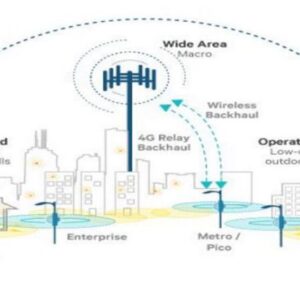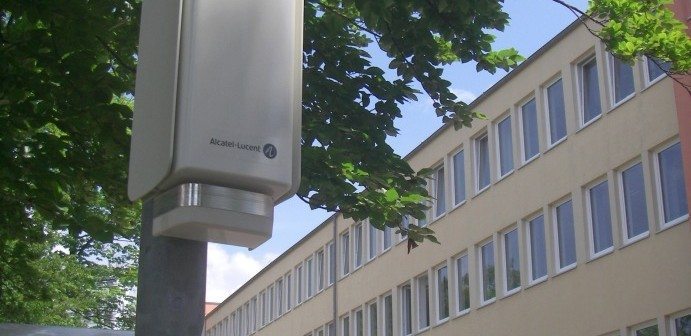While the requirements for “5G” won’t be set until at least 2020, two principles are emphasized in every evolution of cellular standards: capacity and coverage. Small cells are at least a partial solution to meeting those two requirements, and the Small Cell Forum believes the technology will soon “dominate the mobile infrastructure.”
“Small cells” is an overarching term for low-powered radio access nodes that help provide service to both indoor and outdoor areas. These nodes can work in either licensed or unlicensed spectrum, and have a range between 10 meters and two kilometers. The purpose of installing small cells is to increase range and capacity in densely populated urban areas that cannot be sustained by macrocells. Similar to distributed antenna systems, the growth of small cells is a response to increasing global data traffic, which Cisco estimates will have increased 11-fold between 2013 and 2018.
Why small cells?
Small cells have defined purposes when it comes to providing end users an improved cellular experience in congested urban areas.
- Increasing capacity in areas with high user densities;
- Improving coverage and available data rates;
- Extending handset battery life by reduced power consumption.
Types of small cells and deployment scenarios
There are three types of small cells: femtocells, picocells and microcells. Those terms are not entirely standardized and it is important to note that usage may overlap.
Femtocells have the shortest range of small-cell types, and are usually deployed in homes or small businesses. These router-like devices are installed by clients and can accommodate coverage for just a few users at a time. Femtocells generally have a maximum range of less than 10 meters.
Picocells are usually installed in larger indoor areas like shopping malls, offices or train stations. They can support up to 100 users at a time and have a range of under 200 meters.
Microcells are the largest and most powerful small cell. They are usually installed outdoors on traffic lights or signs, and can be used temporarily for large events. Microcells have a range of under two kilometers, whereas macrocell towers can cover up to 20 miles. Both microcells and picocells are usually installed by network operators.
A backhaul problem
The most problematic and restrictive element carriers face when deploying a small cell network is backhaul. Finding a site for deploying a small cell can be a painstaking processes. Carriers must first determine the owner of the build site and negotiate a plan for installation. Sites are often owned by the city, which may have any number of restrictions on placing devices in its jurisdiction.

There are several ways to provide small cells with a signal from a macrocell, including the use of bonded copper, fiber or wireless microwaves, but each of these methods has advantages and disadvantages. Fiber connections provide the highest throughputs, but can be expensive without an already established infrastructure. DSL, or copper, provides limited data rates, and also requires the use of pre-established networks. Wireless, on the other hand, requires navigation of varying line-of-sight conditions.
Establish appropriate backhaul is also time-consuming. Verizon Wireless is deploying small cells in several U.S. cities, including New York, Chicago, Atlanta and San Francisco. In May, Verizon Communications CFO Fran Shammo said at the MoffettNathanson Media and Communications Summit that it takes two years from start to finish to deploy a small cell network.
“It is about a 24-month period of time by the time you get a location, you negotiate with the landlord, you get the fiber to that location, because every single one of our small cells has fiber backhaul to a macro cell,” he said.
Requirements
For the implementation of a small cell network to be a financially sound investment for carriers and enterprises it must adhere to a few requirements.
- Low cost – Coverage is being provided to fewer subscribers, so costs must be kept down.
- Easy to manage – The huge number of small cells being deployed means consolidated management is necessary.
- “Outdoor furniture” appearance and light-weight design – Small cells are often mounted to street lights and signs, so there can be restrictive requirements laid out by landowners.
- High weather reliability and safe-to-touch design – Small cells provide street-level coverage and are in close proximity to human activity.
Advantages
- A solution for improving coverage in small areas at low power outputs;
- Reliable and effective coverage and capacity;
- Very small footprint;
- Lower comparative cost and higher flexibility than macrocells or distributed antenna systems
- “Whereas DAS systems for big venues and buildings would deploy capacity for 40 sectors with hundreds of special antenna pulls, a small cell system could easily add 200 sectors of 3G/4G capacity for 25% of the cost, as compared to DAS – not counting yearly operating expense,” Ronny Haraldsvik, former SVP and CMO of SpiderCloud Wireless wrote in a column. “That is closer to 50 to 100 times different. The DAS business case makes good sense for 1 million to 10 million square feet. Below a million, the business case now favors small cell systems.”
Disadvantages
- Lack of orchestration across different systems and groups;
- Uncertain deployment time for small cells due to site acquisition and zoning;
- Backhaul continues to be a costly and complex problem for carriers
- Crown Castle said it takes 18 to 24 months to deploy small cells for an anchor tenant, with additional tenants taking nine to 18 months to come online, according to a recent RCR Wireless News report. Many projects started during the peak of initial small cell hype are just now being turned up, and deployment numbers should grow from here.
- Power is required that is often not accessible at the point of installation.
Market outlook
In 2013, 98% of mobile operator respondents said they believed small cells would be “essential” for the future of their networks, according to a report by Informa Telecoms and Media. But that deployment has proven difficult over the years.
To put the costs of backhauling into perspective, the total capital and operating expenditures for small cell deployments in London over 10 years is around $141 million and $1.42 billion, respectively, according to an Intel case study.
Still, small cells prove to be much more cost-effective than installing a three-sector LTE macro cell, which has a total cost of ownership over a five-year period of $279,412, assuming a 50:50 mix of wireless and fiber backhaul. This can cost up to six times as much as 3G small cells, according to a report by Senza Fili Consulting.
Sprint last summer set a goal of deploying tens of thousands of small cells with hopes of completing the project within two years. Mobilitie, the company handling site acquisition and deployment for Sprint, said fewer than 2,000 had been deployed by May 2016, according to an RCR Wireless News report.
We reached out to Sprint for an update, but representatives declined our request for an interview.
Although the demand for small cells hasn’t held up to its lofty expectations, the need for the technology in the near future seems unavoidable.
According to analyst firm Mobile Experts, carrier small cell deployments grew 140% in 2015, including both indoor and outdoor units; the growth rate “will be even bigger in 2016,” said Joe Madden, principal analyst for Mobile Experts. The firm expects enterprise small cell shipments to double in 2016 with a 270% spike in sales growth. It also estimates that enterprise small cell shipments will be worth $4 billion annually by 2020. Transparency Market Research, meanwhile, predicts the global femtocell market to be worth $4.7 billion by 2019, according to an RCR Wireless News report.
The impending prospect of a 5G network
The digitization and more efficient management of small cell systems through the use of technologies like C-RAN will allow the budding technology to adapt to a new network standard. Because of this, some experts believe small cells have a brighter future than DASs when it comes to 5G compatibility. In a recent interview with RCR Wireless News, Huawei’s president of small cells product line, Peter Zhou compared the future of small cells favorably to that of distributed antenna systems.
“Those new technologies have to be smoothly integrated,” he said. “More and more operators are starting to understand that indoor systems like DAS cannot have a smooth evolution. We have to use digitalized systems. Considering 5G, we start to think about new applications like virtual reality, 4K video and new vertical industrial applications. It’s not going to happen with the legacy systems that purely rely on the macro baseband outdoor or the analog system like DAS.”
Visit Qualcomm 5G Microsite for more resources, developments and insights.

